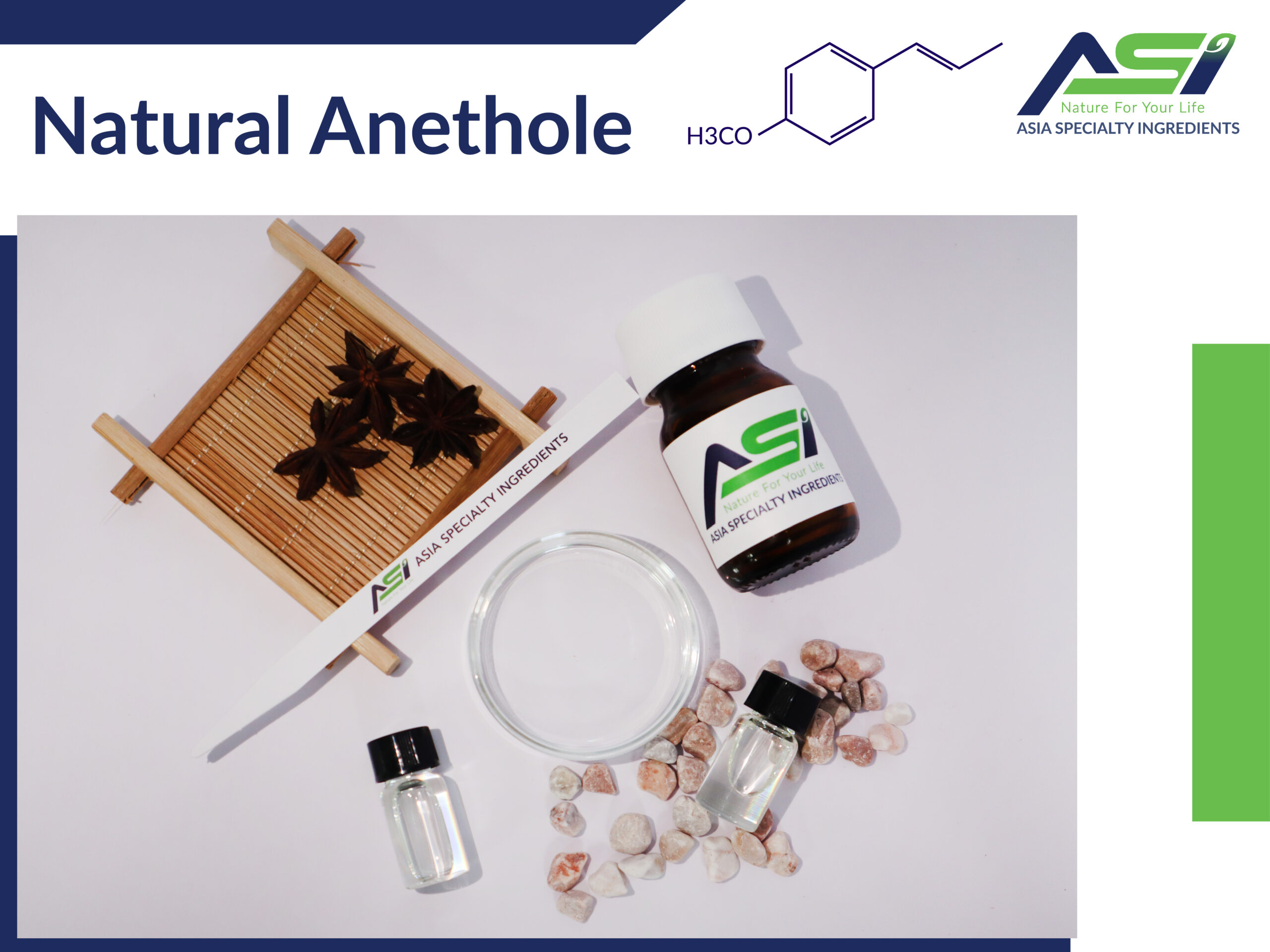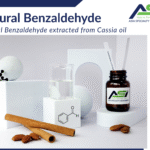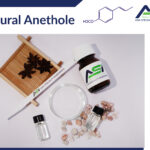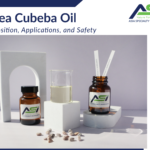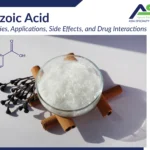As naturally derived compounds gain popularity across various modern industries, anethole has emerged as a remarkable natural aromatic/flavor/fragrance/scent substance. Natural anethole is not only known for its sweet and pleasant scent but also for its promising properties and wide range of applications. This blog provides an overview of natural anethole, covering its origin, main properties, and applications across different sectors.
Table of Content
ToggleWhat is Anethole?
Anethole (C10H12O), chemically classified as a phenylpropene, is an organic compound widely found in the essential oils of several aromatic plants, particularly from tropical species in the Apiaceae and Schisandraceae families. It has two isomeric forms, trans– and cis-anethole, but the trans- isomer (E) is more stable and preferred for use. Anethole has the chemical structure 1-Methoxy-4-(prop-1-en-1-yl)benzene/1-Methoxy-4-(prop-1-enyl)benzene. The molecule consists of a benzene ring attached to two functional groups: a methoxy group (–OCH₃) and a propenyl group (–CH=CH–CH₃). This structure contributes to its characteristic sweet aroma, making it an essential component in various applications such as flavoring in the food industry, perfumes, pharmaceuticals, etc.
Anethole has a boiling point of approximately 234°C, a refractive index of 1.5570-1.5610 at 25°C, and a density of about 0.983-0.988 at 25°C. Anethole is insoluble in water but highly soluble in ethanol. When water is added to a mixture of anethole and ethanol, it forms a microemulsion – a phenomenon known as the ‘ouzo effect’. In industry, synthetic anethole can also be produced from anisole derivatives and propionic acid, but the increasing demand for natural products has driven the focus on plant-based extractions.
Natural Sources of Anethole
Natural anethole is regularly found in the essential oils of several aromatic plants such as anise (Pimpinella anisum), star anise (Illicium verum), and fennel (Foeniculum vulgare). These plants have traditionally been used in culinary and medicinal formulations across various cultures due to their distinctive sweet fragrance & flavor and recognized health benefits. The star anise oil from Vietnam contains over 86% trans-anethole and less than 1% cis-anethole, making it one of the commercially viable natural sources of anethole in Vietnam. The remaining ~13% consists of minor constituents such as estragole, D-limonene, linalool, foeniculine, alpha-pinene, beta-caryophyllene, and other trace aromatic compounds that contribute to this oil’s characteristic fragrance and flavor.
Table 1.1. Percentage of trans-Anethole in several essential oils.
|
Essential oil |
Trans-Anethole |
| Star Anise | >86% |
| Anise | 75-90% |
| Fennel | 50-60% |
Properties of Natural Anethole
The physicochemical properties of anethole play a crucial role in determining its applications in various industries. Natural anethole is typically a colorless to pale yellow liquid or solid, with a sweet, licorice-like aroma. This compound is prone to photoisomerization and oxidation, especially when exposed to UV light or high temperatures.
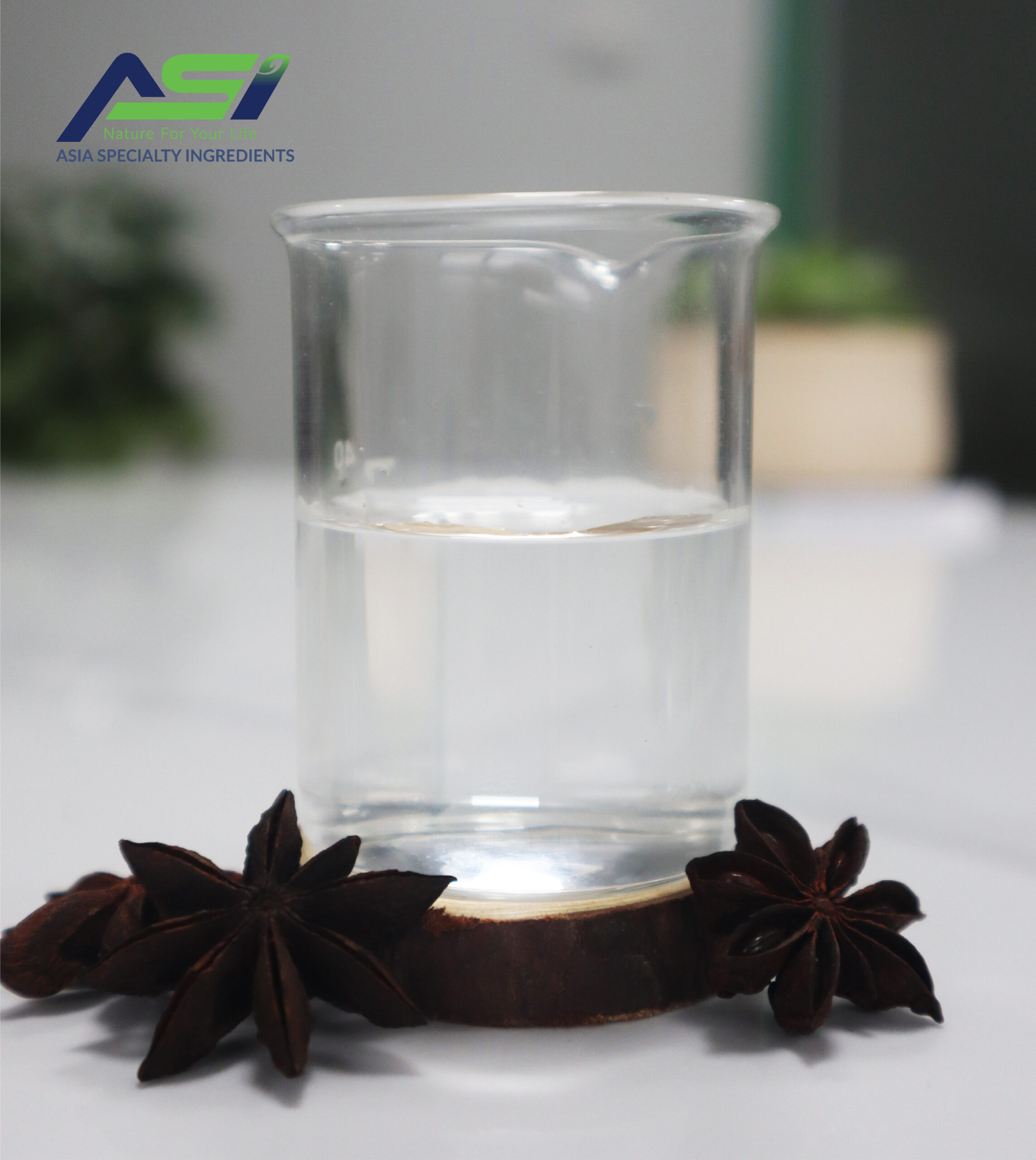
Figure 1.1. Natural Anethole extracted from Star Anise Oil
Moreover, natural anethole exhibits antibacterial properties and effectively inhibits the growth of several types of bacteria, fungi, and yeasts. In addition to its antibacterial effects, anethole also demonstrates significant antioxidant activity, contributing to its potential in preventing oxidative stress-related damage. Furthermore, several studies have highlighted its anti-inflammatory and analgesic effects, showing its role in modulating inflammatory responses and pain relief. These diverse biological properties emphasize the potential of trans-anethole as a valuable compound for medical and cosmetic applications.
Applications of Natural Anethole
Food and Beverage Industry
Natural anethole, particularly the trans-isomer, is a key flavoring compound in the food and beverage industry thanks to its sweetness—approximately 13 times that of sugar—and its characteristic licorice-like aroma. It is commonly used to impart flavor in a wide range of products such as confectionery (e.g. licorice candies, chewing gum), baked goods (e.g. Lebkuchen), and traditional anise-flavored alcoholic beverages like pastis, ouzo, and raki. Natural anethole is typically used at very low concentrations, often below 0.1% by weight in food formulations.
In addition to its flavoring role, natural anethole exhibits antimicrobial and antifungal activities, making it a promising natural compound for food preservation. These properties help enhance product safety and shelf life without relying on synthetic preservatives.
Regarding safety, trans-anethole is recognized as Generally Recognized As Safe (GRAS) by the U.S. FDA under 21 CFR 182.60 and is affirmed by global food safety authorities including FEMA (FEMA GRAS No. 2086) and JECFA (Flavour No. 217). The European Union permits its use as a flavoring substance under Regulation (EC) No 1334/2008 without no re-evaluation needed. Dietary exposure remains low, with typical intake levels measured in micrograms per kilogram of body weight per day.
Pharmaceuticals
Anethole’s antibacterial and antifungal properties have led to its use in oral care products, cough syrups, and antiseptic formulations. It also shows anti-inflammatory, antispasmodic, and analgesic effects, making it beneficial in the treatment of various conditions. Moreover, anethole has been investigated for its potential in cancer therapy, including breast, prostate, lung, and colon cancers.
In clinical observations, an oral dose of 500 mg given to healthy volunteers resulted in no detectable levels of the parent compound in the bloodstream after 24 hours, suggesting efficient metabolism. In preclinical research, trans-anethole has been tested in a wide dosage range—from as low as 0.05 mg/kg up to 1500 mg/kg in rodents. In animal nociception models, oral doses between 62.5 and 500 mg/kg demonstrated significant anti-inflammatory and analgesic activity without impairing motor functions or producing sedative effects. However, there is currently no officially established therapeutic dosage for trans-anethole in human medicine.
Cosmetics
Natural anethole is valued in cosmetics for its soft, sweet, licorice-like scent that adds warmth and sweetness to many personal care products. It’s often used as part of a fragrance blend in perfumes, soaps, shampoos, lotions, and creams. While fragrance oils may account for 0.2% to as much as 30% of the total formula depending on the product type, the actual amount of anethole is typically very low—often below 1% of the finished product.
Although anethole is widely used in cosmetics for its pleasant, sweet aroma, it is also recognized as a potential allergen. According to Commission Regulation (EU) 2023/1545, issued on 26 July 2023, the European Union amended Regulation No. 1223/2009 to enhance transparency in labeling fragrance allergens. Specifically, anethole must be listed on the product label if its concentration exceeds 0.001% in leave-on products or 0.01% in rinse-off products. As a result, cosmetic manufacturers must carefully monitor the concentration of anethole in their formulations ensure proper labeling compliance, and avoid potential sensitization risks for consumers.
Agriculture and Animal Feed
Naturally sourced trans-anethole, typically extracted from star anise, fennel, and anise, can be used as an additive in animal feed due to its pleasant aroma and ability to enhance feed palatability. According to the European Food Safety Authority (EFSA, 2025), trans-anethole is authorized for use in feed for all avian species, at a maximum inclusion level of 25 mg/kg of complete feed, without requiring a withdrawal period. EFSA also concluded that this use level poses no risk to consumers or the environment. As such, naturally derived trans-anethole presents a promising option for feed manufacturers seeking to transition toward plant-based, safe, and environmentally friendly additives.
Trans-anethole has also been studied for its potential as a bioactive compound capable of repelling or controlling insects, nematodes, mites, and fleas. However, to date, trans-anethole has not been registered as an active substance in pesticide products in the European Union or the United Kingdom, in accordance with Regulation (EC) No. 1107/2009 and the Control of Pesticides Regulations (COPR).
In the United States, the Environmental Protection Agency (EPA) issued a tolerance exemption in 2022 (87 FR 26684), allowing trans-anethole to be used as an inert ingredient in pesticide formulations applied to pre-harvest crops. Under this regulation, the concentration of trans-anethole must not exceed 3% of the total formulation, and no tolerance (maximum residue limit) is required on food or feed commodities. In this role, trans-anethole is typically used as a fragrance or natural aroma carrier, complementing the activity of other biopesticidal ingredients, rather than acting as a primary active substance.
At ASI we offer Natural Anethole extracted from Star Anise Oil. Learn more here: Natural Anethole
Conclusion
Anethole is not only attractive because of its pleasant fragrance but also due to its unique physicochemical and biological properties, making it a potential ingredient in various industries. The extraction and application of anethole from natural sources not only meet market demands but also open up sustainable development opportunities for the future.
Asia Specialty Ingredients (ASI), part of Asia Ingredients Group (AIG), specializes in the production and global export of essential oils and natural aromatics. Our range of products is meticulously processed using only the finest natural ingredients sourced from the typical lands of Vietnam, including Cassia, Basil, Star Anise, Litsea Cubeba and more, ensuring good product quality. Contact us for more collaboration opportunity!
References
- Hasegawa, T., Seimiya, H., Fujihara, T., Fujiwara, N., & Yamada, H. (2014). Aroma profile. of star anise and the structure-odor relationship of anethole. Natural Product Communications. https://pubmed.ncbi.nlm.nih.gov/24689303/
- ChemicalBook. (n.d.). cis-Anethol (CAS 104-46-1). https://www.chemicalbook.com/ChemicalProductProperty_EN_CB0228732.htm
- El-Kersh, D. M., et al. (2022). GC-MS metabolites profiling of anethole-rich oils by different extraction techniques: Antioxidant, cytotoxicity and in-silico enzymes inhibitory insights. Journal of Enzyme Inhibition and Medicinal Chemistry. https://www.ncbi.nlm.nih.gov/pmc/articles/PMC9302011/
- Damayanti, A., & Setyawan, E. (2012). Essential oil extraction of fennel seed (Foeniculum vulgare) using steam distillation. International Journal of Science and Engineering. https://download.garuda.kemdikbud.go.id/article.php?article=1392355&val=1252&title=Essential%20Oil%20Extraction%20of%20Fennel%20Seed%20Foeniculum%20vulgare%20Using%20Steam%20Distillation
- Marinov, V., & Valcheva-Kuzmanova, S. (2015). Review on the pharmacological activities of anethole. Scripta Scientifica Pharmaceutica. https://doi.org/10.14748/ssp.v2i2.1141
- Kurniawan, J. M. (2023, July 9). Understanding the stability and degradation of essential oils: A comprehensive review. PT Mitra Ayu. https://www.ptmitraayu.com/single-post/understanding-the-stability-and-degradation-of-essential-oils-a-comprehensive-review
- Almeida, M. I., & Silva, A. M. (2024). Anethole in cancer therapy: Mechanisms, synergistic potential, and clinical perspectives. Toxicology and Applied Pharmacology. https://doi.org/10.1016/j.taap.2024.115381
- Flavor and Extract Manufacturers Association. (n.d.). trans-Anethole. https://www.femaflavor.org/flavor-library/trans-anethole
- World Health Organization. (1998). trans-Anethole (JECFA 217). Joint FAO/WHO Expert Committee on Food Additives (JECFA). https://apps.who.int/food-additives-contaminants-jecfa-database/Home/Chemical/2295
- U.S. Food and Drug Administration (FDA). (n.d.). Substances Added to Food (Anethole). Retrieved from https://www.eumonitor.eu/9353000/1/j4nvk6yhcbpeywk_j9vvik7m1c3gyxp/vj3i7x7drxy4
- European Union Monitor. (2014). Anethole – Food Flavouring Substance Evaluation. Retrieved from https://www.hfpappexternal.fda.gov/scripts/fdcc/index.cfm?set=FoodSubstances&id=ANETHOLE
- Wikipedia. (n.d.). Anethole. Retrieved from https://en.wikipedia.org/wiki/Anethole
- Joint FAO/WHO Expert Committee on Food Additives (JECFA). (1992). Anethole. Retrieved from https://www.inchem.org/documents/jecfa/jecmono/v28je10.htm
- Da Silva, F. V., et al. (2014). Effects of Anethole in Nociception Experimental Models. Retrieved from https://www.researchgate.net/publication/269715107_Effects_of_Anethole_in_Nociception_Experimental_Models
- European Commission. (2023). Commission Regulation (EU) 2023/1545 on the use of flavorings including trans-anethole. Retrieved from https://eur-lex.europa.eu/legal-content/EN/TXT/PDF/?uri=CELEX:32023R1545
- U.S. Environmental Protection Agency (EPA). (2022). trans-Anethole; Tolerance Exemption. Federal Register, May 5, 2022. Retrieved from https://www.federalregister.gov/documents/2022/05/05/2022-09621/trans-anethole-tolerance-exemption
- University of Hertfordshire. (n.d.). trans-Anethole – Pesticide Properties Database (PPDB). Retrieved from https://sitem.herts.ac.uk/aeru/ppdb/en/Reports/2339.htm

